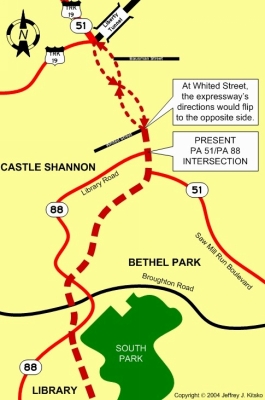
South Hills Expressway

South Hills Expressway
When one looks at a map of Pittsburgh, what probably stands out is that there is not an expressway that heads due south of the city. Other parts are connected via I-279 or I-376, which are appropriately referred to as the Parkway East, West, and North. However this will be rectified with the construction of the Mon-Fayette Expressway, even though it will follow the Monongahela River which is more of a southeasterly direction. This means that the communities south of the city will still be left without an expressway connection without heading west to I-79 or east to PA Turnpike 43. There was a time when those were not to be the only options.
In 1963, the Pittsburgh Area Transportation Plan called for an expressway to begin at the southern end of the Liberty Tunnel and head through the South Hills to Washington County near South Park. The plan was officially announced by the Pennsylvania Department of Highways on May 10, 1966. The $100 million limited-access highway, devised to alleviate South Hills-to-Downtown traffic congestion and open up the Monongahela Valley, would parallel Saw Mill Run Boulevard from the tunnel to the intersection with PA 88, and would comprise a total of six lanes with three lanes on either side of PA 51. This section has also been referred to as the Saw Mill Run Expressway. At about a quarter of a mile south of Bausman Street, the two sections would converge and cross current PA 51 with northbound traffic on the west side and southbound traffic on the east side of the alignment, creating the look of a British motorway. At Whited Street, the two sections would rejoin with each direction on the standard side and follow a path between PA 51 and PA 88 from their intersection in Overbrook. Then it would head through Whitehall and Castle Shannon, along the western edge of South Park without disrupting the park itself, and ending just beyond the park's southern edge. Interchanges would have been constructed at the following locations:
|
 |
| Detailed map of the South
Hills Expressway at the left shows the path it would have taken though the southern suburbs. Also shown is the part where the two directions of traffic would have flip so that vehicles would be traveling on the opposite side that they would normally for a north-south highway. |
| Click on map for a more detailed plan. |
Eventually it would be extended into Washington County to intersect with Interstate 70 at a point near Charleroi. In Allegheny County, the expressway would comprise 12.35 miles. Construction on the part from the tunnel to Overbrook had been planned to start by 1970, with some portions of that starting earlier. G. C. Margeretto, assistant district engineer for the Department of Highways, said it would take three years to design the new and complex interchange at the southern portal of the Liberty Tunnel. That estimate was made without considering the addition of a third tube. "A third tube is almost a necessity, according to our figures," Margeretto said. Those figures indicate that 50,000 vehicles use the tunnel and would jump to 76,000 in two decades. One of the uncertainties is the completion of the Oakland Crosstown Freeway, which could reduce the need for a third tube.
It was calculated that $29 million of the $100 million total would be devoted to acquiring the property in the right-of-way. This figure was in line with the common finding of $1 million to $2 million a mile for acquiring land within an urban area. Although the consulting engineers, J. E. Greiner Company of Baltimore, Maryland, did not find any major landmarks in the path of the expressway, one casualty would have been the Overbrook Junior High School. Margeretto said, "The decision today is a highways department finding that this route is economically feasible, that it serves the greatest number of people and that it gives the best traffic services." The original idea was to relieve Downtown traffic, but after long study it was decided to view the entire South Hills as a system rather than trying to solve a piece of the problem at a time. He went on to say, "It will take a few years to build, but at least we will know where we are going."
After the plans were announced, a group of residents from Whitehall Borough formed Whitehall Residents Against The Highway (WRATH). The reason for the formation of WRATH was that the new expressway would cut through Whitehall Borough but provide no entrances or exits. Also, they said that the six-lane highway would divide the borough, destroy 175 homes, and render some unusable. While they acknowledge the need for a new expressway, the residents feel that the highway should be laid out along PA 88 and that it should be incorporated into a new rapid transit system.
On May 29, 1966, WRATH announced a plan to incorporate the project with a transit system. The concept was borrowed from the Eisenhower Expressway in Chicago, which featured a six-lane expressway with a rapid transit line in the median. They suggested a "transit highway" on PA 88 to capitalize on that artery's proximity to the Castle Shannon trolley. No encouragement was offered on the idea, even when Whitehall Councilman Frank J. Mundy presented the plan to the Department of Highways and there was no measurable reaction. J. Paul Ambler, district highway engineer, said that the combined design would be too expensive and complicated. It would require more right-of-way, and pose great problems at interchanges. Committee members contacted Port Authority Transit, but were told no commitments were possible until they received recommendations from a survey that was being conducted at the same time by Parsons, Brinckerhoff, Quade, and Douglas.
Whitehall property owners whose homes were along the proposed expressway route complained that the Commonwealth never explained why the route was switched from the PA 88 alignment. They disputed claims that the PA 88 design would cost $113 million, while a $104 million price tag was placed on the original plan. This would carry the expressway though a mostly vacant gully between Weyman and Provost Roads, to a point between South Passage and Village Lane at Castle Village Shopping Center. From there it would bridge Grove Road just west of Spring Valley Drive and continue to Bethel Park via Highgrove Road.
Another problem that got the group angry at the State was that a planning meeting for the expressway was set for 1 PM on June 29, 1966. Whitehall Borough council wired Governor William Scranton with the following statement: "We protest the actions of the State Highways Department setting a one PM time for the public hearing...an afternoon hearing will deprive hundreds of persons of the right to be heard unless they sacrifice work and time away from their jobs."
The meeting was eventually moved to July 7, 1966 and attended by about 1,000 people in the Baldwin High School auditorium. Frank J. Mundy, a Whitehall councilman, said of the project, "We are here tonight to protest as strongly as possible the location through Whitehall of the proposed limited access Legislative Route 247, Routes 51 and 88." He was also armed with 3,515 signatures on a petition opposed to the plan of building the expressway through Whitehall. Also in attendance was Robert W. Cunliffe, assistant attorney general, who set the ground rules early by saying, "The purpose of this hearing is to obtain evidence of the economic effect this highway will have on the area through which it passes. It is not an adversary proceeding, and by that I mean there will be no cross examination or questions permitted by any witness." A few hours before the meeting, the Allegheny County commissioners announced their "full support" of the State's plan. Also in favor of the plan was John F. Cromwell, the Director of the Washington County Planning Commission. H. L. Aitken, Pennsylvania project manager for J. E. Greiner Company, the consulting engineers which recommended the final route, explained that four other routes were studied before the final one was chosen. He said, "The recommended line (through Whitehall) is seven million dollars less costly than the cheapest location in the valley (through Castle Shannon)." When asked about the lack of access in Whitehall, he said that an approach is designed for the intersection of PA 51 and PA 88. "You will be close to the interchange, but not too close and this is how we feel you would want it," he added. The plan would slice through 400 homes, 40 commercial properties, and four churches; however, one of the other routes would mean 540 residences, 110 businesses, and five churches would have to be razed. Frank Mundy said, "We insist that if you announce your decision--against the weight of the evidence that this route go through Whitehall--that you do it immediately, not months nor years from now--and that you immediately condemn and acquire all the property along this route." John T. Mauro, planning and development director for Pittsburgh stepped up and candidly admitted that the City didn't care whether the expressway went through Whitehall or Castle Shannon. "The traffic problem is in the City near the Liberty Tubes and not in the suburbs," he added.
Another person upset by the plan was Reverend Lawrance O'Connell, pastor of St. Gabriel's Church. He was concerned that the expressway would displace about one-fourth of his parishioners. Pittsburgh District Highways Engineer William S. Stephens said that every effort not to split the parish would be made.
On March 5, 1968, it was announced that construction would commence on the expressway by the end of 1970 on the Bausman Street to Overbrook section. Construction on the $7.3 million interchange at the southern end of the Liberty Tunnel would begin in early 1971. Another portion near the Washington County line would begin in the spring of 1971 and cost $15 million, but it was still in the design state as was a 3.1 mile section from South Park to the Washington County line. The last item in the project would be a complete renovation of the Liberty Tunnel including new lights, titling, and ventilation system which would cost $700,000 and start in late 1970.
On February 22, 1969, another revised timetable was announced by the Department of Highways. The property buying schedule for sections along PA 51 and PA 88 was released with the first properties to be purchased on PA 51 between Bausman Street and Crane Avenue starting in mid-1970. The timetable was as follows:
On September 10, 1970, the State Transportation Commission of the Department of Transportation announced that it had approved plans to begin the final design of the South Hills Expressway. The commission did so only on the agreement between federal and local authorities to share the cost of cleaning up Saw Mill Run. The price tag of that preliminary project came in at $43 million, which would be added to the $74 to $100 million cost of the expressway.
The expressway was cancelled in the mid-1970s due to financial problems at PennDOT. The South Hills did get the rapid transit system, wanted by the Whitehall residents in a revised South Hills Expressway plan, in 1985 when Port Authority Transit opened "The T" subway system from Downtown to Library along the old trolley lines. In 1997, construction began on the single point diamond interchange at the southern end of the Liberty Tunnel and was completed on November 20, 1999.
Links:
PA 88
PA Turnpike 43
Oakland Crosstown Freeway (Cancelled)
Saw Mill Run Expressway (Cancelled)
Southern Circumferential (Cancelled)